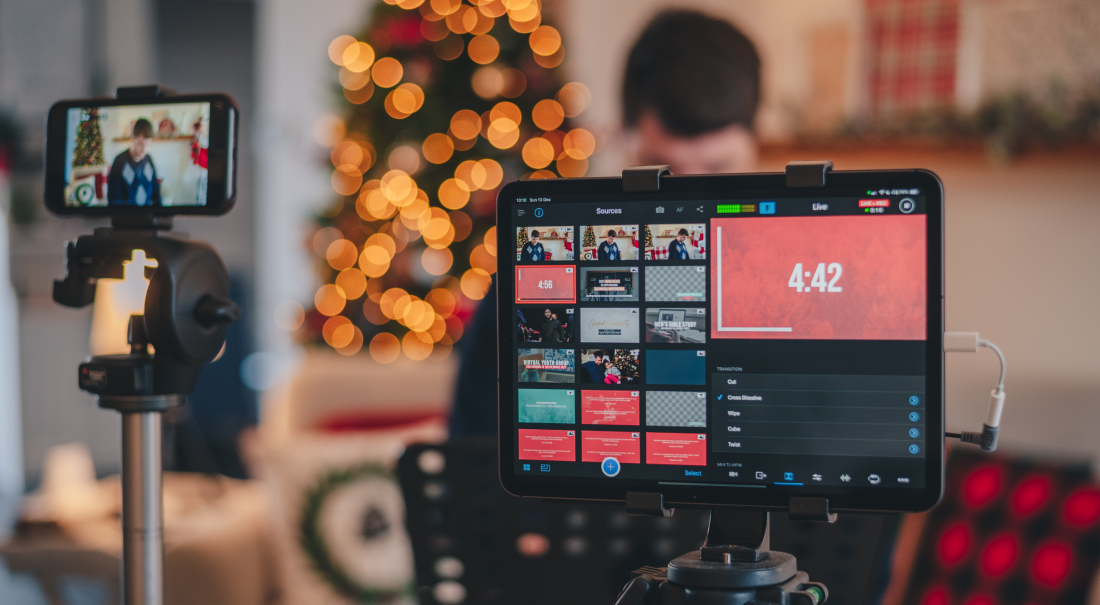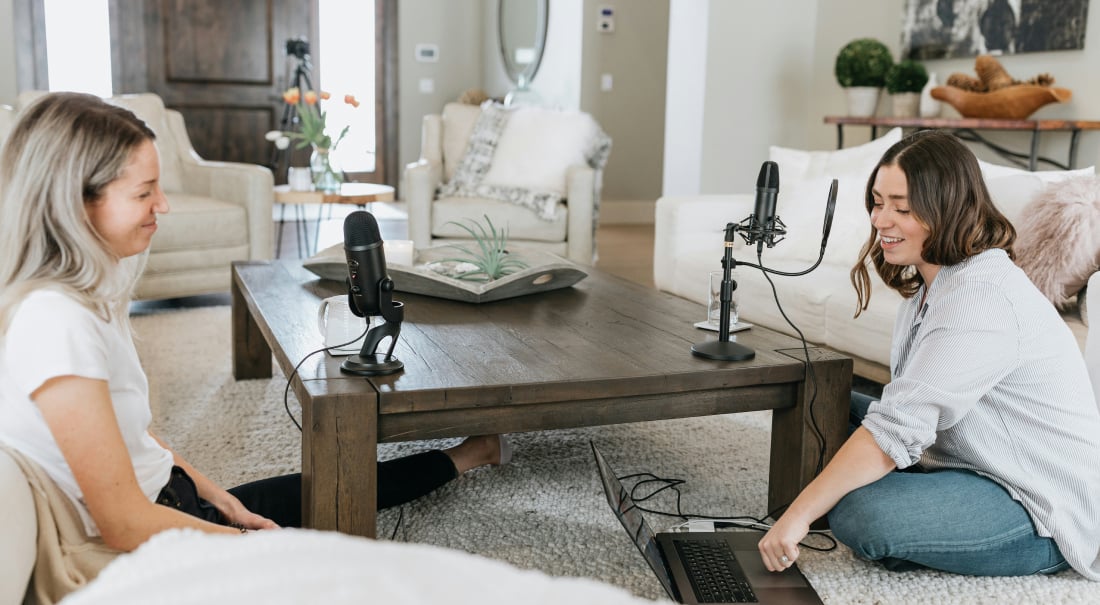
You want to know how to start a podcast, but wonder, will anyone ever hear it? You have ideas. You have something worth sharing. But you don’t have an audience yet.
The good news? Most successful podcasters started the same way. No listeners. No subscribers. Just a clear sense of why they wanted to speak and a willingness to take the first step.
This podcasting guide is here to help you build from that place. You’ll learn how to:
-
Define the value you want to offer
-
Turn early ideas into real episodes
-
Make your show discoverable
-
Grow a community around it over time.
If you’re starting a podcast from zero, you’re in the right place. Let’s get started.
Find your why: Define the purpose of your podcast
Before you think about episodes or platforms, it helps to understand why you want to start this podcast in the first place.
Your “why” is the foundation of your show.
It shapes what you talk about, how you talk about it, and why listeners should care.
When you’re starting a podcast with no audience, this clarity matters even more. It gives you direction on the days you’re unsure, and it keeps your podcast grounded in something real.
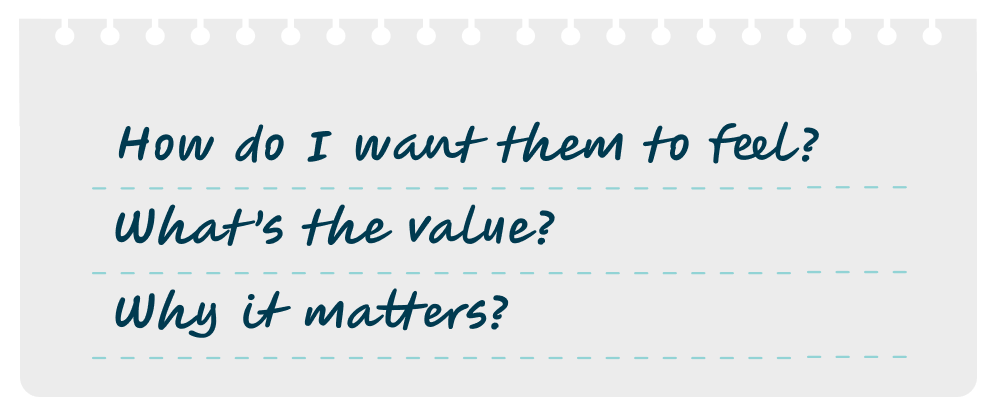
Start by asking yourself a few simple questions:
-
What do I want people to feel after listening to my show? Maybe you want them to feel understood, inspired, entertained, or just less alone.
-
What value do I want to bring into someone’s day? A new insight. A laugh. A practical tip. A moment of calm.
-
Why does this podcast topic matter to me? Your connection to the topic is part of what makes the show worth hearing. When you care, that comes through.
Let’s walk through an example:
Imagine you’re starting a podcast about Roman history. You’re not trying to sound like a textbook. You want listeners to feel curious and connected, like they’re learning something new alongside a friend.
-
What do I want people to feel after listening? You want them to feel that spark of discovery, the “I never knew that” moment that makes history feel alive.
-
What value do I want to bring into someone’s day? A brief escape. A surprising story. A small insight they can carry with them or share later.
-
Why does this podcast topic matter to me? You’ve always been drawn to the everyday humanity of Rome. The jokes, the routines, the worries that look so much like ours. That connection across time is the reason you want to share these stories: to show that we’ve always been more alike than we are different.
As you jot your answers down, you’re discovering the emotional heart of your podcast. Once you know that, everything gets easier. Your episodes have focus. Your voice feels more natural. And when someone new stumbles on your show, they’ll feel that sense of purpose, too.
Craft a unique angle to attract a particular audience
Once you understand why you want to create a podcast, the next step is shaping what makes it yours.
When you don’t have an existing audience, a unique angle helps new listeners understand why your show is worth their time.
This doesn’t mean reinventing an entire genre or forcing a gimmick. It simply means finding a perspective only you can bring.
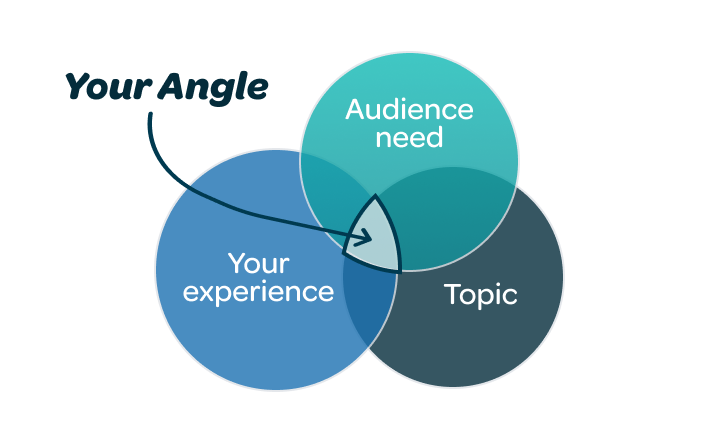
Begin by exploring a few ideas:
-
What conversations do I wish existed, but never seem to find? Often, the show you want to hear is the one you’re meant to create.
-
What personal experience or lived perspective shapes how I talk about this podcast topic? Your background, your job, your community, your sense of humor — these are all assets.
-
How can I combine two ideas that don’t normally go together? Some of the most engaging podcasts live at an intersection: creativity and mental health, tech and parenting, small business and storytelling.
For example, imagine you’re starting a podcast called The Creative Reset, a space for people rebuilding their creative habits.
-
What conversations do I wish existed, but never seem to find? Honest talks about burnout. The quiet kind that creeps in when life gets busy, and creativity slips to the side.
-
What personal experience shapes how I talk about this? You’ve been there yourself. You know the feeling of wanting to make things again but not knowing where to start, and that lived experience gives your perspective warmth and credibility.
-
How can I combine two ideas that don’t normally go together? Your show blends creativity and self-care. It’s part reflection, part practical check-in — a simple mix that helps people reconnect with their creative energy without the pressure to be perfect.
If you’re feeling stuck, create a few practice recordings just for yourself. Sit down with your phone, hit record, and talk through a topic you care about.
Don’t worry about structure or perfection.
These early experiments will help you hear your natural tone, notice what excites you, and find the threads you want to follow.
At this stage, think of your angle as a hypothesis, not a final decision. You’re discovering your voice so you can attract the right audience over time. It’s something you get to test, refine, and adjust as you make your early episodes.
Choose your podcast format
Once you know what you want to talk about, the next step is deciding how you want to bring those conversations to life. Your podcast format shapes the feel of your show, and the right choice is usually the one that feels most natural for you.
Here’s how to find the best podcast format for you:
Begin with your podcast topic
Some ideas naturally fit certain podcast formats. A story-driven show has room to breathe in a narrative structure. An investigative podcast topic may rely on interviews. A reflective or educational show might shine as a solo monologue.
Let your content guide your podcast length
Talk long enough to say something meaningful, but not so long that you’re stretching your topic to fill time. Solo episodes often land on the shorter side. Interviews or conversations naturally run longer.
Consider your listener’s day
Picture where your audience might listen. On a walk. During a commute. While cleaning up the kitchen. Understanding that rhythm can help you shape episodes that fit into real life, not just your outline.
Be honest about your time and resources
If you’re creating your podcast alongside a full-time job or other commitments, running a frequent interview show can be a lot to manage. Scheduling guests, writing questions, and editing long conversations would take time. So, choosing a simpler podcast format would help you stay consistent, especially in the early stages.
Choose a podcast format that feels comfortable for now
You don’t need to lock yourself into one style forever. Many creators start a podcast solo, then add guests later. Others begin with conversations and eventually shift toward storytelling. Let your podcast format support your message and your workflow. You can always adapt as your podcast grows.
The next step?
Plan your podcast episodes
Once you’ve chosen a podcast format and length that feels right, it’s time to map out each episode.
Create a simple podcast episode framework
Begin by creating a simple framework that helps you stay focused without boxing you in during recording. It helps to keep your outline simple.
A few bullet points or a short roadmap is often all you need. Think of it as a gentle guide that keeps your thoughts on track while leaving room for spontaneity.
Your episode plan should give you enough structure to speak confidently and enough freedom to sound like yourself.
Plus, a light outline also makes podcast editing easier, especially if you’re recording a video podcast.
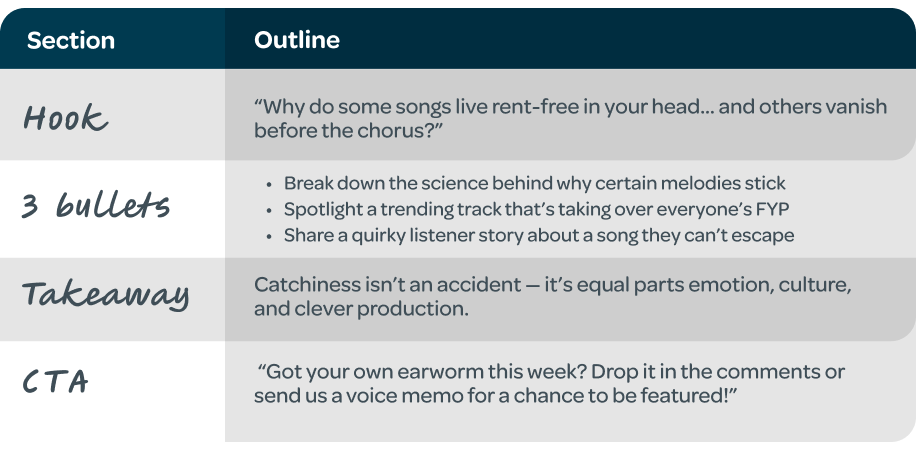
Switcher tip: If you’re recording with Switcher, you can add simple visuals like topic titles or supporting graphics during your episode. These touches help your pacing, support your storytelling, and keep video audiences engaged.
Begin your podcast with a clear opening
Give listeners a quick sense of what the episode is about right away. A simple setup helps new listeners settle in and gives returning listeners a reason to stay engaged.
Make every podcast episode newcomer-friendly
Many people will discover your show out of order. They might jump in at episode three or episode thirteen. A quick sentence of context goes a long way in helping every listener feel included, even on their first day with you.
Create small moments of connection
Share a personal detail, a lesson learned, a story from your week. These moments help listeners feel like they know you, and that sense of familiarity can help build loyalty over time.

Choose your rhythm and stay consistent
Your podcast publishing schedule doesn't need to be perfect. It just needs to be realistic for your life and consistent for your listeners.
Here’s how to do it:
Choose a podcasting schedule you can actually maintain
Weekly, biweekly, or monthly, any rhythm can work as long as you can stick with it. Reliability matters more than frequency. A steady cadence helps listeners know when to expect you, and it helps you build confidence in your own workflow.
Build a small buffer before you launch
Try recording a few podcast episodes ahead of time so you aren’t scrambling once your show goes live. Three to five is ideal. A buffer gives you space to learn, adjust, and settle into your voice without pressure.

Use your early podcast episodes to find your flow
Those first podcast recordings teach you a lot: how long prep takes, how much you like to edit, what pacing feels natural, and what kind of schedule fits your life.
Consistency doesn’t have to be rigid. It just needs to be steady enough that you can show up, create, and keep growing, one episode at a time.
Create a lightweight podcast brand identity
When you’re building a podcast from zero, your brand doesn’t need to be flashy or complicated. It just needs to feel like you.
A simple, consistent identity helps new listeners recognize your show in a crowded feed, even if they’ve never heard your name before.
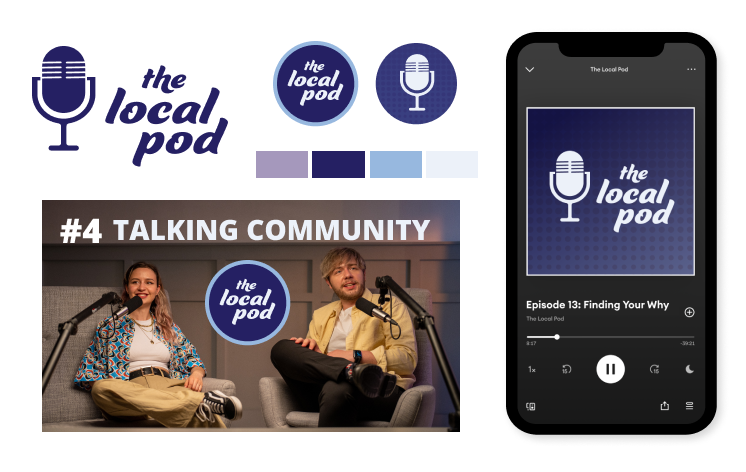
Here are some tips to consider:
Choose a podcast brand look that feels natural
Think about the feeling you want your podcast to create. Calm and reflective? Bright and energetic? Curious and conversational? Let that guide your colors, cover art, and tone. You don’t need a designer. You just need a direction.
Keep your podcast visuals consistent
Your podcast cover, episode thumbnails, and social clips should share the same general style. When someone sees a clip from you one day and a post from you the next, they should immediately connect the dots.
Use tools that make design easier
Tools like Canva make it easy to craft a brand package. Plus, if you record with Switcher, you already have built-in ways to stay consistent. You can add titles, lower thirds, text treatments, and simple branded graphics right inside your podcast video recording. That means your episodes and your social clips already look unified, without needing extra editing software.
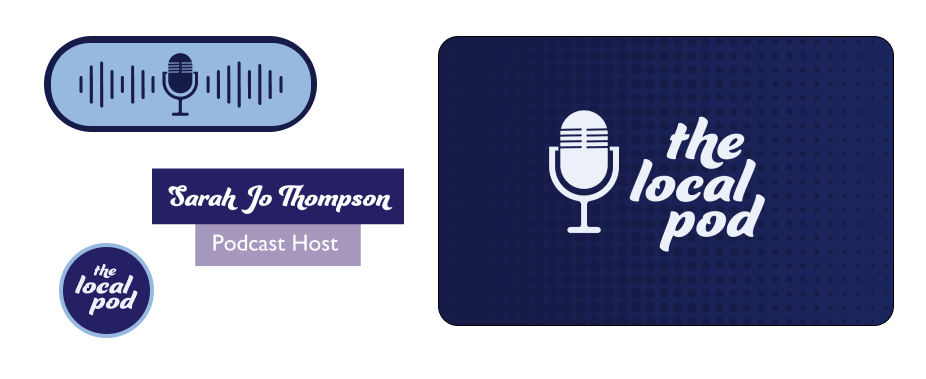
Let your personality lead the way
Your brand identity is more than visuals. It’s your voice, your pace, your presence, and the way you make people feel. Early on, clarity matters more than polish. If someone can listen to an episode and immediately understand your vibe, you’re doing it right.
A lightweight identity gives your audience something familiar to return to. And at this stage, familiarity is a powerful tool.
Enhance your show: Create a video podcast
As podcasting has grown, video has become one of the most reliable ways for new creators to get noticed. It opens doors that audio alone can’t:
Video podcasts are easier to discover
Platforms like YouTube, TikTok, Instagram Reels, and even Spotify help people find new creators through short clips and video recommendations. A single podcast video clip can introduce your show to new people.
Video podcasts help your audience feel closer to you
A quick smile. A raised eyebrow. The way you lean in during a thoughtful moment. These small things make a big difference. They help listeners feel like they’re in the room with you.
Video podcasts create more opportunities for growth
One episode can become multiple pieces of content for social media, blogs, newsletters, and community posts. That flexibility helps you engage more people without creating more content production work.
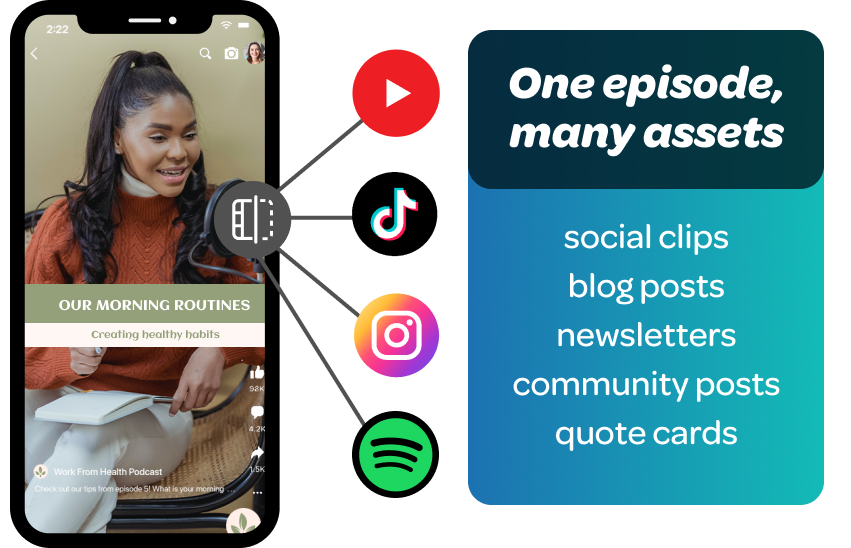
Switcher tip: Switcher’s built-in social media clip generator makes clipping highlights effortless. You can pull out moments that matter most and share them directly to platforms like TikTok, YouTube, and Instagram.
Adding video isn’t required to start a podcast, but for new creators looking to grow, a video podcast can be one of the strongest tools you have.
Create and publish your first podcast episode
Once you’ve shaped your direction, it’s time to bring your first episode to life. You don’t need a studio or a complicated setup to start a podcast. You just need a few essentials and a workflow that feels manageable.
Use podcast equipment you already have
An iPhone, a pair of headphones, and a quiet space go a long way. Many creators begin this way.

If you want a little professional polish, use easy video podcasting software like Switcher to sync your iPhones, iPads, and cameras to record multiple-camera angles. You can also add a logo, overlay screen graphics, invite remote guests, and more.
Choose a podcasting platform
A podcast host is what sends your show to places like Apple Podcasts, Spotify, and Google Podcasts. Look for one that feels easy to navigate and has the features you care about, such as analytics or simple scheduling.

Here are a few popular podcasting platforms to check out: Buzzsprout, Podbean, and Libsyn.
Record, edit, and upload your podcast
Your first episode doesn’t need to be perfect. Just aim for clarity. Speak naturally. Edit lightly. And when you’re ready, add your title, description, and cover art, then hit “publish!”
With your first episode live, you’ll have achieved something important: you’ve moved from planning to publishing. From here, you can start focusing on helping people find your show.
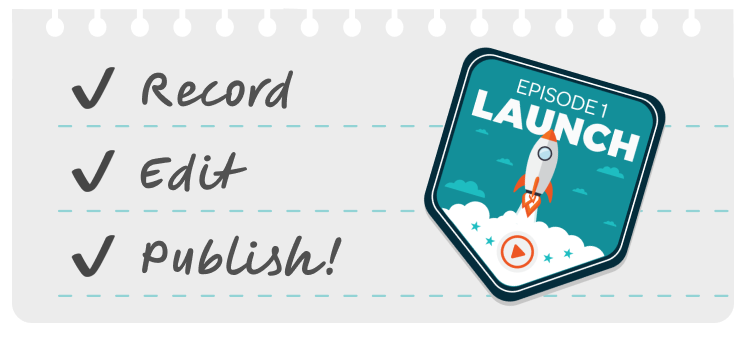
Make your podcast discoverable
Publishing your first episode is a big moment, but discovery is what helps people actually find it.
When you’re starting a podcast without an audience, discoverability is less about the volume of episodes you publish and more about clarity. Clear titles, clear descriptions, and clear signals about who your show is for help the right listeners find you.
Here’s how to do it:
Use podcast titles that say what the episode is really about
A clever title might sound fun, but a clear one gets clicked.
Think about what someone might type into a search engine, then mirror that language. Let people know exactly what they’ll hear when they press play.
For example, if your episode is about how beginners can start watercolor painting, you could call it something clever like “The Joy of Messy Colors.”
But a listener searching for help won’t find you. A clearer title like “How to Start Watercolor Painting as a Beginner” shows up in search engines, tells people exactly what to expect, and gets far more clicks.
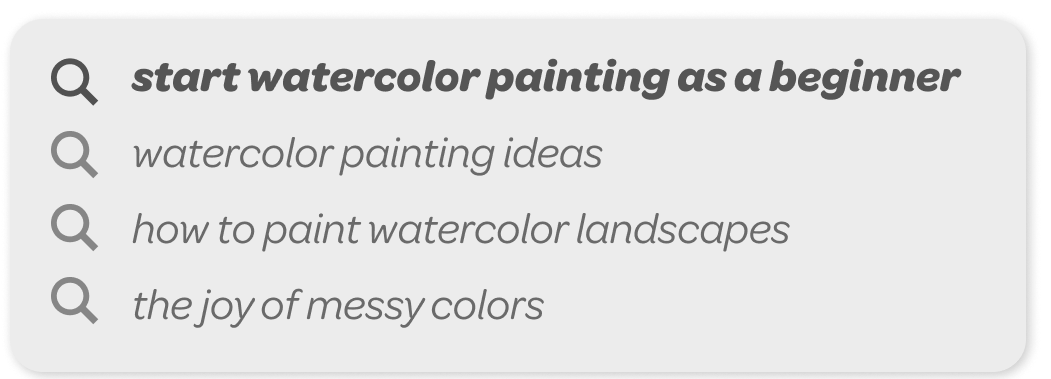
Write simple, helpful podcast descriptions
Tell listeners what they’ll learn or feel in a sentence or two. Keep things honest and readable.
For example, if your episode dives into easy weeknight meals, a description like “Join me as I explore the culinary traditions of my childhood kitchen” feels poetic, but vague.
A clearer description, such as “In this episode, you’ll learn three 20-minute dinner recipes that use five ingredients or less,” tells listeners exactly what they’ll get and helps your episode show up in search engines for quick, simple meals.
Use podcast transcripts when you can
Uploading episode transcripts (written versions of your podcast recording) doesn’t just help the deaf and hard of hearing; they also help search engines understand your content better, leading to more visibility in search results. Use a podcast transcription tool like Otter.ai, Clipto, or Rev to help.
Publish your podcast on social platforms
Uploading your full episodes or highlights to platforms like YouTube and Facebook can help people find you through search and recommendations.
Market your podcast to grow your audience
When you’re starting without an audience, growing your podcast means taking your show to the places where people already spend time.
Discovery rarely happens by accident. It happens because you bring your voice into the right spaces, in the right ways, with intention.
Here are some tips to make it happen.
Share your podcast where your people gather
Look for communities that care about the podcast topics you talk about. That might be a subreddit, a Facebook group, a Discord server, or a niche forum.
Show up as a participant first. Contribute. Answer questions. Share your thoughts. When it’s helpful and relevant, introduce your podcast as a resource, not a promotion.
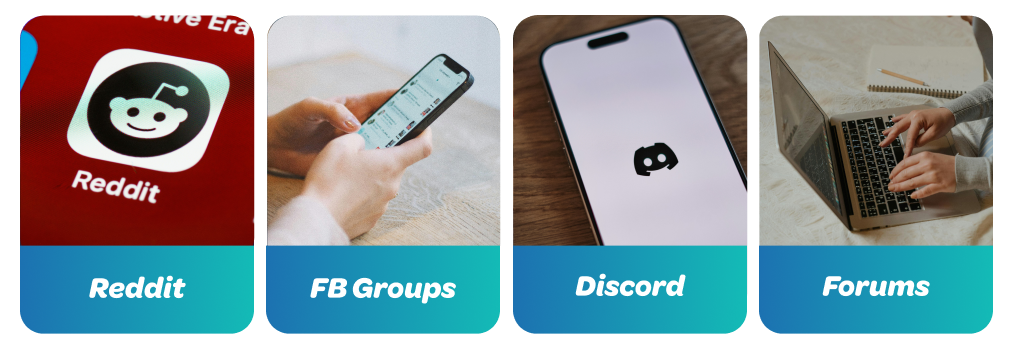
Turn one podcast episode into multiple pieces of content
Short clips are one of the most effective tools for reaching new listeners. They’re quick to watch, easy to share, and perfect for platforms that thrive on short-form video.

Switcher tip: You can pull the best moments from your recording and publish them straight to TikTok, Instagram, or YouTube with Switcher’s built-in social media clip generator.
Collaborate with other creators
Guest episodes, joint livestreams, and cross-promotions help you reach new audiences faster. Think of it as sharing your communities — this is a powerful way to grow, even if they’re small at first.
Make it easy for podcast listeners to stay connected
At the end of your episodes, invite people to subscribe or follow. Keep the ask simple. Let listeners know how to connect with you on social. A friendly reminder goes a long way when someone is already enjoying your content.
All in all, growing an audience without followers is absolutely possible. You don't need to go viral. You can grow by simply giving people small, consistent chances to discover you — one clip, one post, one moment at a time.
Track the podcast metrics that actually matter early on
When you’re starting a podcast without an audience, it’s easy to focus on numbers that feel big and impressive: downloads, followers, charts.
The truth is, those metrics don’t tell you much in the early days. What actually matters are the small signals that show your podcast is resonating with real people.

Look at your podcast completion rate, not total plays
If someone listens through most or all of an episode, that tells you your pacing and content are working. Even a handful of full listens is meaningful when you’re just getting started.
Pay attention to social engagement, not scale
A single comment, message, or review can teach you more than a hundred silent downloads. These early reactions help you understand what people connect with and what they want more of.
Notice what feels sustainable for you
Your workflow is a metric too. Which parts of the process feel natural? Which parts drain you? The goal isn’t perfection. It’s creating something you can return to week after week.
Use podcast video metrics for clearer insights
If you’re sharing clips or full episodes on YouTube or social media, retention graphs can show you exactly where viewers stay engaged or drop off.
Early success is about the strength of engagement, not the number of downloads or views. These are the metrics that help a podcast grow. The other numbers will catch up.
Start your podcast today
Starting a podcast without an audience can feel uncertain, but it also gives you space to experiment, learn, and grow at your own pace.
Don’t chase trends or try to impress. Instead, work to build something rooted in your own voice and your own perspective.
When you stay connected to your purpose, keep your storytelling clear, and show up consistently, people will notice. They’ll find your clips. They’ll hear a moment that resonates. They’ll share an episode with a friend. Bit by bit, your audience will form through real connection.
And if you decide to bring video into your workflow, Switcher can help you share that connection with even more people. With the iPhones or iPads you already own, you can record or stream a polished video podcast, clip out your best moments, and publish them directly to the platforms where your future listeners already are.
If you focus on a message worth sharing and keep moving forward. Your listeners will find you.
Subscribe to the blog
Sign up to receive notifications whenever a new blog post is published. You may unsubscribe at any time.

Share
About the Author

River Law is a storyteller who writes for humans, with heart. Whether it’s helping global brands find their voice or giving startups the words to grow, River brings empathy and clarity to every project. An Englishman who calls California home, River finds his rhythm outdoors with his family.
All posts by River Law

